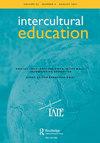儿童与来自不同文化背景的儿童接触的意愿;来自Tec4schools项目的证据
IF 0.8
Q3 EDUCATION & EDUCATIONAL RESEARCH
引用次数: 0
摘要
本文利用2014-2015年从TEC4Schools项目收集的数据,探讨了影响儿童与冲突文化背景的人接触意愿的因素。该项目从在线开始,最终包括面对面的接触。对577名学生的问卷调查结果进行层次回归分析。预测因子分为四个步骤:(1)个人细节(性别和宗教),(2)公平和满意度,(3)协作(在课程中使用协作学习),(4)跨文化态度。跨文化态度和积极经验都与合作有关,并预测了因变量:儿童与来自其他文化的人互动的意愿。满意度和公平性不能直接预测与其他孩子互动的意愿,但可以通过合作来预测。此外,可变的“跨文化态度”是合作的中介,这意味着合作确实通过跨文化态度预测与其他文化互动的意愿。尽管研究结果表明,性别和宗教不能预测互动意愿,但性别和/或宗教在满意度、公平、跨文化态度和合作方面存在显著差异。本文章由计算机程序翻译,如有差异,请以英文原文为准。
Children’s willingness to have contact with children from different cultures; evidence from the Tec4schools program
ABSTRACT This paper explores the factors that predict children’s willingness to have contact with those from cultures in conflict, using data collected in 2014–2015 from the TEC4Schools program which begins online and eventually includes face-to-face contact. Hierarchical regression analysis was conducted on the results of the questionnaire from 577 students. The predictors were entered in four steps: (1) personal details (gender and religion), (2) equity and satisfaction (3) collaboration (the use of collaborative learning in the course), and (4) intercultural attitudes. Both intercultural attitudes and positive experiences are associated with collaboration and predict the dependent variable: the willingness of the children to interact with those from other cultures. Satisfaction and equity do not directly predict willingness to interact with other children but do so via collaboration. In addition, the variable ‘intercultural attitudes’ is a mediator for collaboration, meaning that collaboration does predict willingness to interact with other cultures via intercultural attitudes. Although the findings show that gender and religion do not predict willingness to interact, there are significant differences in gender and/or religion in satisfaction, equity, intercultural attitudes, and collaboration.
求助全文
通过发布文献求助,成功后即可免费获取论文全文。
去求助
来源期刊

Intercultural Education
EDUCATION & EDUCATIONAL RESEARCH-
CiteScore
2.30
自引率
8.30%
发文量
36
期刊介绍:
Intercultural Education is a global forum for the analysis of issues dealing with education in plural societies. It provides educational professionals with the knowledge and information that can assist them in contributing to the critical analysis and the implementation of intercultural education. Topics covered include: terminological issues, education and multicultural society today, intercultural communication, human rights and anti-racist education, pluralism and diversity in a democratic frame work, pluralism in post-communist and in post-colonial countries, migration and indigenous minority issues, refugee issues, language policy issues, curriculum and classroom organisation, and school development.
 求助内容:
求助内容: 应助结果提醒方式:
应助结果提醒方式:


